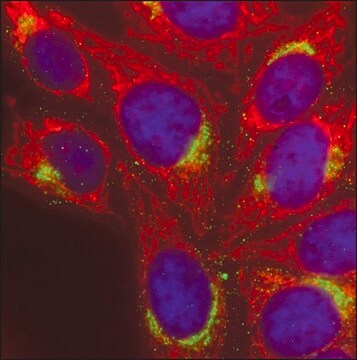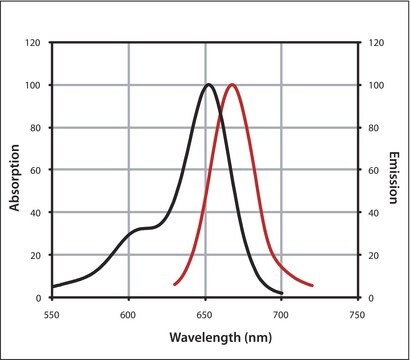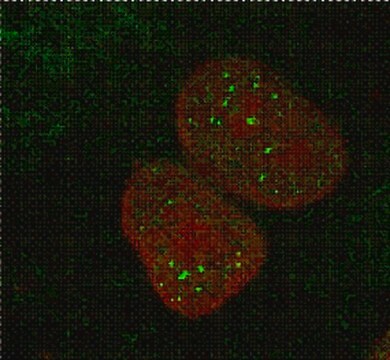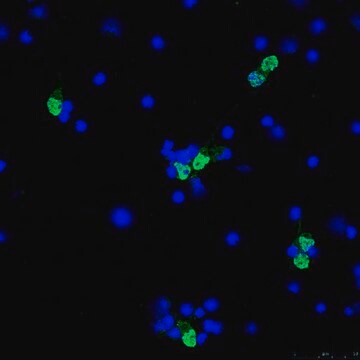MAB4310X
Anti-CD133 Antibody, clone 13A4, Alexa Fluor™ 488 conjugated
clone 13A4, Chemicon®, from rat
Sinónimos:
Prominin-1, AC133
About This Item
Productos recomendados
origen biológico
rat
Nivel de calidad
conjugado
ALEXA FLUOR™ 488
forma del anticuerpo
purified antibody
tipo de anticuerpo
primary antibodies
clon
13A4, monoclonal
reactividad de especies
mouse
no debe reaccionar con
Drosophila, rat, chicken, human
fabricante / nombre comercial
Chemicon®
técnicas
flow cytometry: suitable
entrada
sample type epithelial cells
sample type hematopoietic stem cell(s)
sample type: mouse embryonic stem cell(s)
sample type mesenchymal stem cell(s)
sample type neural stem cell(s)
isotipo
IgG1κ
Nº de acceso NCBI
Nº de acceso UniProt
Condiciones de envío
wet ice
modificación del objetivo postraduccional
unmodified
Información sobre el gen
chicken ... Prom1(422825)
human ... PROM1(8842)
mouse ... Prom1(19126)
rat ... Prom1(60357)
Descripción general
Especificidad
Inmunógeno
Aplicación
Note: This antibody does not work with paraffin-embedded sections.
EM immunohistochemistry: The subcellular localization of the 13A4 antigen in mouse E9-10 neuroepithelial cells and adult kidney proximal tubule cells was investigated by immunogold electron microscopy. Strong labeling was observed over the kidney brush border membrane, where 13A4 immunoreactivity appeared to be concentrated toward the tips of the microvilli. Remarkably, in neuroepithelial cells, whose apical plasma membrane contains fewer microvilli than the kidney brush border, 13A4 immunoreactivity was associated mostly, if not exclusively, with microvilli and plasma membrane protrusions, and was not detected in the planar areas of the apical plasma membrane. Because of this preferential localization, the 13A4 antigen was referred to as ′′prominin′′ (from the Latin word ′′prominere,′′ to stand out, to be prominent) (Weigmann et al., 1997).
Western blotting: 1-5 μg/mL in 0.3% Tween in PBS. Sample preparation: Standard Laemmli (boiled in 2% SDS, 100mM DTT or 5% beta-mercaptoethanol, 60mM Tris-HCL pH 6.8). Preferred Gel percentage: 7.5%. Suggested Blocking Buffer: 3-5% Milk, 0.3% Tween in PBS. Incubation time: 1 hour at room temperature or overnight at 4°C. Recommended control extracts: Positive: Kidney membrane; Negative: liver membranes.
Immunoprecipitation: 10-25 μg/mL. Suggested tissue/cell lysis buffer: RIPA bufferFinal reaction volume: 500-1000 μL. Final total protein concentration in reaction mix: 0.5-3 mg/mL. Incubation times: overnight at 4°C. Capture agent used: Protein G Sepharose™ or rabbit anti-rat antibody/protein A Sepharose. Expected sizes on immunoblots (in kDa): 115 kDa (mature form) or 105 kDa (precursor form).
FACS Analysis: Suggested dilution/number of cells: 0.25-1 μg/ million cells. Fixation/Permeabilization used: BD FACS lysis Solution (1-1.5% formaldehyde) (BD and FACS are trademarks of Becton, Dickinson and Company) No permeabilization. Recommended controls: Hematopoietic stem cells.
Optimal working dilutions must be determined by the end user.
Stem Cell Research
Neural Stem Cells
Hematopoietic Stem Cells
Forma física
Almacenamiento y estabilidad
Nota de análisis
Human embryonic stem cell lysate, Caco 2 (Human colonic carcinoma cell line) whole cell lysate
Otras notas
Información legal
Cláusula de descargo de responsabilidad
Unless otherwise stated in our catalog or other company documentation accompanying the product(s), our products are intended for research use only and are not to be used for any other purpose, which includes but is not limited to, unauthorized commercial uses, in vitro diagnostic uses, ex vivo or in vivo therapeutic uses or any type of consumption or application to humans or animals.
¿No encuentra el producto adecuado?
Pruebe nuestro Herramienta de selección de productos.
Código de clase de almacenamiento
12 - Non Combustible Liquids
Clase de riesgo para el agua (WGK)
WGK 2
Punto de inflamabilidad (°F)
Not applicable
Punto de inflamabilidad (°C)
Not applicable
Certificados de análisis (COA)
Busque Certificados de análisis (COA) introduciendo el número de lote del producto. Los números de lote se encuentran en la etiqueta del producto después de las palabras «Lot» o «Batch»
¿Ya tiene este producto?
Encuentre la documentación para los productos que ha comprado recientemente en la Biblioteca de documentos.
Nuestro equipo de científicos tiene experiencia en todas las áreas de investigación: Ciencias de la vida, Ciencia de los materiales, Síntesis química, Cromatografía, Analítica y muchas otras.
Póngase en contacto con el Servicio técnico







